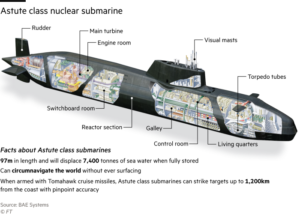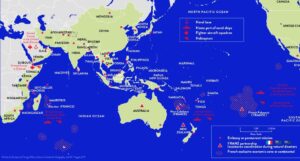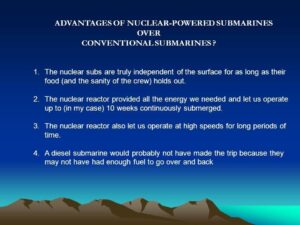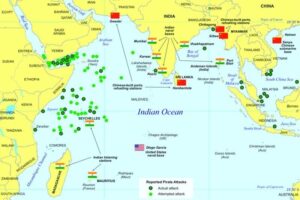By Arundhuti Saha 14 November 2022
Introduction
“China’s economic & military capacities as well as
its belligerence have led to a shift in regional security paradigms”
– The Hindu
The above text from the leading Indian newspaper (The Hindu) simply attempts to infer how global politics is now on the edge of taking a shift driven by what the Chinese rising military power is giving a sign of. The ‘adverse impact on regional stability’ and the rapidly growing belligerent nature along with its high-end military capacity has obliged all the major global players to review their military and security settings, and eventually give it a new shape. Reviewing their strategic policies has become more crucial, especially for the major players in world politics. In this regard, the three major developed countries – Australia, the United Kingdom (UK), and the United States (US) have come up with a new deal, AUKUS, which has taken the main stage of controversy now among scholars of global politics.
AUKUS is a tripartite security pact concerning the stability of the Indo – Pacific region. The deal remains a setback to France (one of the major players in the Indo – Pacific region) as through AUKUS, Australia cancels the prior submarine deal with France worth 66 Billion dollars by joining the deal with the US to produce nuclear-powered submarines along with acquiring nuclear reactor technologies. The action of AUKUS can be analyzed from multiple ways and angles as it will eventually stand against the Chinese assertion in the Indo – Pacific and create a new balance of power in the region with nuclear powered submarine exercises in near future. The deal can also be discussed from the account of QUAD, QUAD Plus and the New QUAD (very recently announced) and how it can make changes in India’s plan. Lastly, the AUKUS plan also reflects the big British stepping in world politics in its post Brexit era. Carrying so much intensity the deal (AUKUS) has been called “the most significant security arrangement after World War 2”. This Anglosphere strategic propaganda is now all set to be in action which might actually invite more nuclear activity in the stage of world politics. This article attempts to explore and analyse the objective of this currently discussed security pact. Along with that, this essay also tries to find out the Indian perspective and predict an Indian response to the action of AUKUS through discussion and comparison.
The Ruckus Behind AUKUS
It is needless to mention and is prominent from the current media discussion that AUKUS has precisely triggered a ruckus over its announcement all over the world. But before getting into the deal straight, it is essential to shed some light on the background of the pact which is about to help Australia produce 8 nuclear powered submarines concerning the Indo – Pacific region. Looking 70 years back from now, the United States had only shared this submarine technology with Britain and now sharing again with Australia calling it a “one off” deal. The US calling it a “one – off” deal evidently interprets that this technology has no probability to be shared with any other nation in future which also signals that the US only desires the specific nuclear submarine formula to be contained within the few major powers only.
Along with this, we can also observe how for the first time in history a non nuclear country (Australia) is about to get hold of eight powerful nuclear submarines which eventually invites more nuclear debates all around the world and especially among the nuclear countries. Prior to AUKUS, looking 4 years back, a diesel-electric submarine deal worth 66 billion dollars had taken place between France and Australia. In this context, now France prefers to call it ‘backstabbing’ following Australia’S abrupt withdrawal from the deal without any prior notice and engagement with the US. France showed a strong sense of repercussion following the huge financial deficit, to both Australia and the US, which has been a long-standing ally for Paris throughout history. France has also questioned the influence of NATO over controlling strategic stability in the Indo-Pacific region in ‘its own way’.
The Australian Essentiality of AUKUS
In reference to this discussion, now the question arises about what made Australia take such a bold step further risking the foreign relation with one of the major players of global politics, that is France. For this understanding, again it is essential to understand the submarine deal from the scientific perspective as well as at the expense of regional strategic dynamics. It is evident that it is high time for all the Indo-Pacific countries to review their defence capacity as well as strategy and Australia, nonetheless, lies in the heart of the region. The Royal Australian Navy already has many functioning ‘conventional’ submarines which are now being regarded as lesser than required compared to the Chinese assertiveness in the region.
The Chinese mainland already possesses the world’s fastest-growing fleet of sub-surface combatants and its nuclear-powered submarines are already on the roll in the Indo – Pacific
- which remains one of the driving triggers behind Australia’s planning to own nuclear There are a few problems that lie with the nature and functions of the conventional submarines, which calls for a change in the maritime setting of the country.
- LOW BATTERY – The conventional submarines’ battery capacity is usually half of the nuclear attack submarines and they essentially need to surface to recharge their battery as it is operated by diesel and electric mechanisms. By floating up to the surface for breathing purposes it leaves room for its enemies to make the submarines be spotted and noticed. The detection risk absolutely makes it dangerous for naval security in presence of Chinese nuclear missiles and warships in the Indo-Pacific
But the nuclear attack submarines are of much longer life expectancy and the high-performer nuclear reactors do not need to surface for refuelling in small intervals. Thus, lesser chance of being spotted and longer patrol. For example, the new US Virginia class SSNs can live in deep water without refuelling for 33 years.
- SPEED & CAPACITY – Unlike nuclear submarines, conventional submarines are less speedy inside the water which makes the flexibility complex. Besides, conventional submarines are capable of carrying lesser weapons than required for naval security in a zone like the Indo-Pacific. A nuclear attack submarine is double faster than the conventional one with easy moves and better flexibility

Also while attacking the target it can reach upto 1200 km with pinpoint accuracy. The tremendously speedy nature of SSNs makes them unique in their way and a necessary naval weapon to acquire for all the main players of the Indo-Pacific especially.
The Expanding Indo-Pacific & The French Perspective
In the 21st century, the Indo-Pacific region is talked about among IR scholars as the most vital as well as a constantly emerging zone in the map of global politics. The region is in a state of continuous expansion concerning the main players of the current century, China and the US. Although a deal like AUKUS is a proper response to the rapid Chinese assertion in the region, it also leaves room for a noticeable power vacuum in the gameplay. On account of the cancellation of prior France – Australia nuclear deal of 66 billion dollars, France likes to call the AUKUS deal a genuine “backstab” from Australia’s side. It is needless to mention that it’s crucial for the western powerhouses to indulge in the Indo-Pacific power game to have their presence acknowledged by China.

French Presence in the Indo Pacific
As the stretch of the Indo-Pacific region goes up to the African borders it seems more bad news for France considering the scattered French presence in the Indian Ocean Region (IOR). In the eastern sea of Madagascar, the volcanic island La Réunion has a population of near about 8,50,000 French citizens. Next, the archipelago of Mayotte on the northern coast of Mozambique, which is essentially an overseas French department and region is again home to roughly 3 lacs French nationals.
Additionally, French Polynesia along with Futuna, New Caledonia, and Wallis also hosts a significant number of French people as well as 7-8 thousand Frency Army Personnel in the region overall administered from the mainland. Hence, the French absence in the Indo-Pacific of course delivers a strong power vacuum with the news of other western presences in the region. In this regard, the AUKUS can be considered a great setback in the great powerplay from a French perspective. As a repercussion of the incident calling it “unacceptable between allies and partners” Paris has immediately called back its ambassadors from the US and Australia claiming the AUKUS deal was a ‘brutal’ American decision. France has also shown concern about how the deal can create mistrust among the NATO members as well as between two main European powers. From an Indian perspective, it can be a great opportunity for India to make stronger bilateral relations with France and restore French confidence & pride.
The Indian Insight of AUKUS
All the sensation about AUKUS is centering the nuclear submarine technology the US is about to share with Australia which is necessarily available only to the permanent 5 members of the UNSC. Now, to discuss the Indian insight into the AUKUS deal it is highly essential to shed light on India’s submarine history and its future submarine plans. Back in 1999, the Vajpayee government had sanctioned the plan for the production of 24 conventional submarines propelled by diesel and electricity to be completed by 2030.
Presently India has 15 conventional submarines and now the Modi regime has adopted the plan to produce nuclear submarines under Project 75 Alpha.
➢ Project 75 Alpha
 The objective is to produce six nuclear-powered submarines to strengthen the nation’s maritime security. The plan was approved in 2015 with an initial budget of 100 Crore rupees and the construction is expected to commence on 2023-24 hoping the first submarine in 2032. As per the media report the designing process of the SSNs by
The objective is to produce six nuclear-powered submarines to strengthen the nation’s maritime security. The plan was approved in 2015 with an initial budget of 100 Crore rupees and the construction is expected to commence on 2023-24 hoping the first submarine in 2032. As per the media report the designing process of the SSNs by
The directorate of Naval Design has been successfully done in 2020. The submarines will have the capacity to carry 18 land attack cruise missiles and heavy-duty torpedoes. The project means a big turn for the nation’s defence as it produces the nation’s first domestic nuclear-powered submarines. Talking about nuclear submarines, India has been a user of Russia’s nuclear attack submarines (‘Charlie I’ and ‘Akula II’ class). India was now exercising maritime patrol using the Russian submarine Nerpa: K-152 (renamed as INS Chakra) on lease on a 10 years deal. Project 75 Alpha will benefit the nation by competing with the PLA’s navy ships in the Indo-Pacific and further polish maritime security, especially after the AUKUS deal, to restore its presence of power in the region.

India – China Strategic Significance of Indo Pacific
➢ How Much an Indian Insight Is Necessary
The AUKUS deal affects the Indian defence sentiment for numerous reasons. After the AUKUS deal, it is now more important for the nation to restore its presence of power in the Indo-Pacific region. A crowd of numerous nuclear submarines in the Eastern Indian Ocean will eventually erode Indian pre-eminence in the region.
Having the presence of Chinese nuclear submarines in the IOR, India’s pace of SSN production is not noteworthy. Although the stronger naval patrol of Canberra will work in favour of Indian security balancing the Chinese presence in IOR, the deal also raises the question of the US’s indifferent approach to its two different QUAD partners. Some years back, US’s rejection to share the modern naval nuclear reactors technology with India, when requested and now sharing it with another QUAD partner raises the question of a partnership deficit. Most importantly, the implication of AUKUS taking away the focus from QUAD is what makes India concerned with regional collective security.
➢ Hunt For New Possibilities
Although India’s two SSBNs (nuclear-powered ballistic missile submarines) INS Arihant and INS Arighat are scheduled to be commissioned this year, India still faces the need for the reappraisal of its strategic environment and reinforce deterrence against China. The 2021 QUAD summit vows a Free, Open, and Inclusive Indo-Pacific free from assertiveness and coercion. India’s policy of Free and Open Indo-Pacific (FOIP) gives an open approach to other countries’ participation in the region, probably to contest the Chinese presence in the IOR. In that regard, the AUKUS products will be enough of contenders as per the need, but at the same time, it is high time for India to hunt for new possibilities to speed up production and acquire the naval reactor technology.
A predictable Indian Response –
Concerning the importance of QUAD & IOR’s future after the AUKUS deal, here are some probable Indian responses to balance it with other contenders in the Indo-Pacific.
In Solidarity With France
India’s story of handling a polite rejection of receiving naval nuclear technology from France in 2017, is now all set to get revised. According to scholarly discussions, it’s a precise chance for New Delhi to seize the opportunity to stand in Solidarity with France and to indulge in a greater bilateral relationship. The stronger the partnership is, the more possibility of acquiring nuclear propulsion technology from France to build SSN reactors.
Necessarily, India has been keeping a similar approach immediately after the announcement of the AUKUS deal as per the Indian PM’s action of calling Macron to show solidarity and support. Along with France, India’s approach to other Southeast Asian countries can help build a stronger identity and presence in the region.
Recent Development – “A True Strategic Partnership”
On the sideline of the G-20 summit (October 2021) French president Macron has been engaged in conversation with the Indonesian president and Indian PM respectively about constructing better security ties in the Indo-Pacific after being locked out of AUKUS. The French side has met common willingness after indulging with the leading Asian nations. After the France – India talk, another follow-up meeting next week is about to materialise joint propaganda. France’s reiteration to work more closely with India over the Indo-Pacific stability gives hope for the nation to build a better response to Chinese assertion. Through a strategic alliance with France and Indonesia and being a member of the QUAD at the same time, the nation eventually has the possibility to work out exclusive diplomatic naval exercises in the region.
Maintaining QUAD
The presence of Australian nuclear submarines in the most important trade water (involving the Malacca strait) is absolutely appreciable from an Indian security perspective. At the same time, it is crucial for the country to keep the QUAD partnership at the same importance level. The importance of the Malabar exercise has become deeper now with the involvement of Australia in 2020. India’s approach to the New Quad (of the middle east) along with the US, Israel, and the UAE is also to see another strategic alliance in the extended Indo-Pacific. Not to mention the probable QUAD plus arrangement is to open up other new avenues involving the participation of South Korea, Vietnam, and New Zealand. The future QUAD plus can be a strong potential ally by having Vietnam in the team which is essentially a South China Sea country. Hence, with AUKUS India can very indirectly achieve what is necessary if the approaches are made cautiously, being in line with QUAD, QUAD plus, and New QUAD. All in all the utilisation of all sources should only concern a stronger Indian identity in the region.
Criticism
Is Pakistan The Next?
The Chinese reaction over AUKUS has been very negative calling it a stance of nuclear proliferation while at the same time China floats its own nuclear submarines in the same maritime zone. But still, China has not hesitated to criticise the tripartite agreement, blaming it for inviting nuclear arms in the busy trade routes of Indo-Pacific. So it can be easily assumed that a deal like AUKUS opens up doors for China’s allies like Pakistan to acquire nuclear submarine technology from China. Pakistan has already shown interest in expanding and reshaping its naval forces. So, AUKUS has received criticism for enabling the possible availability of such nuclear technology to other nonnuclear countries along with training for the operations of such devices. Other than Pakistan, countries like North Korea and Iran have the probability to be potential customers of China.
Conclusion
Although the AUKUS deal gives India a feeling of a bystander, for Australia to get more equipped and lifted with naval armor will eventually contribute to the acceleration of QUAD moves. Also, on a positive note, the deal also gives chances for India to be involved in strategic partnerships with a P5 country like France. The deal overall gives a proper response to the Chinese assertiveness in the South China Sea where it is building artificial islands and has already succeeded in installing 27 military outposts. Now after the Indo – French talk at the 2021 G-20 summit it is highly likely for the country to go for a joint operation in the Indo-Pacific which has the possibility to include more Southeast Asian countries. Both the deals overall will add all the separate allies as a part of the Indo-Pacific security calculus contributing to the resistance against Chinese political and economic coercion through the region.
From the above analysis and discussion, the anticipation of Australia to make a new Balance of Power in the Indo-Pacific is nearly evident, although eighteen years is too much time to wait to witness the manifestation of the plan. For Britain, the AUKUS deal is seen to be a big step in the Post Brexit era to prove its strength and independence in Europe as well as to the entire globe. Britain is seeing the AUKUS deal also as an opportunity to be involved in the strategic gameplay of the main power frame and also to regain its legacy of external affairs outside of Europe.
Bibliography
- The Big Deal Behind The Ruckus Over AUKUS
~ Sujan R. chinroy, The Hindu (22nd September, 2021)
- AUKUS, strategic autonomy, and the future of the Indo-Pacific: A French perspective
~ Andrea Moreschi, Observer Research Foundation (4th October, 2021)
- Quad leaders to strive for ‘free, open, inclusive’ Indo-Pacific region unconstrained by ‘coercion’ ~ Deccan Herald (13 March, 2021)
- “True Partnership”: France Seeks To Enhance Ties With India, Indonesia
~ NDTV (30th October, 2021)
- The QUAD, AUKUS and India’s Dilemma
~ Manjari Chatterjee Miller, Council on Foreign Relations (cfr), (13th October, 2021)
- AUKUS : Questions of Nuclear Proliferation and Global Percepts
~ Sujay Bhattacharyya, India Today (29th September, 2021)
